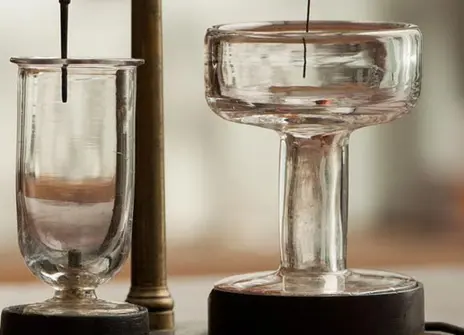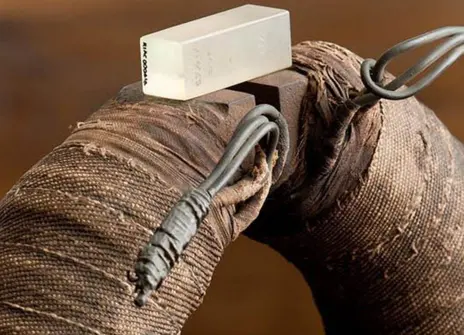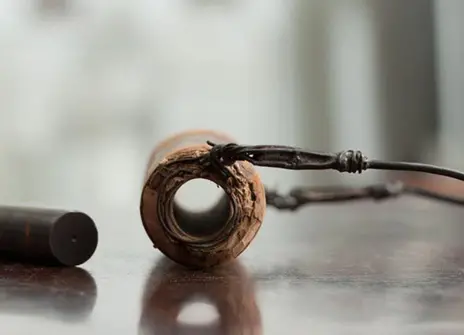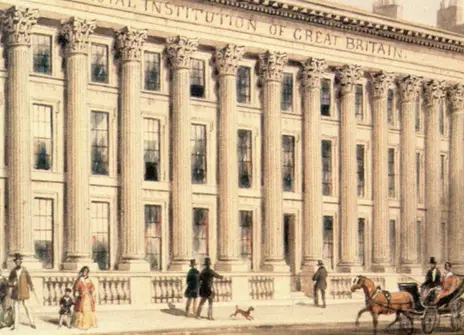Michael Faraday lived and worked at the Royal Institution from 1812 almost to the end of his life. He was a chemist, a populariser of science, the inventor of the electric motor, transformer and generator, a consultant to the government and inspiration for revolutions in physics beyond his time.
This walk from the Royal Institution to Somerset House explores aspects of Faraday’s life and the haunts of other leading figures associated with him (2 miles or about 3km, 1.5 hours).
Royal Institution of Great Britain, 21 Albemarle St
Set off from the Royal Institution itself on Albemarle Street. In his youth, the telegraph engineer Sir William Preece heard Faraday at the Ri. “His lectures on a ‘Candle’ contained more of romance to me than all the operas, plays and books that I was allowed to see…” Faraday inspired many others, including William Perkin inventor of the first synthetic dyes.
Brown’s Hotel, 33 Albemarle St
From 1864 until 1892 this was the regular meeting and dining place of the X Club, formed by biologist T. H. Huxley to develop science free of religious dogma. Faraday’s protégé and successor as a professor at the Ri, John Tyndall, was a member.
The Niagara Room commemorates a meeting chaired here by Lord Kelvin in 1890 during the 'battle of the voltages'. It sought to determine the best method for distributing power from the Niagara hydroelectric plant. Faraday’s 1831 discovery of electromagnetic induction made alternating current an option. It was while answering a query from Kelvin that Faraday discovered in 1845 that light was affected by an electromagnet.
London Home of Ada Lovelace, 3 St James’s Square
The home of Faraday’s friend Ada Lovelace, best known for her association with computer pioneer Charles Babbage, has a blue plaque. Ada was taught maths as an antidote to the influence of her father, the poet Lord Byron. Ada had a very intense and personal correspondence with Faraday, a married man and conservative Christian. This at first he indulged. Later he sought to distance himself from her.
Gas Light, Crown Passage
Crown Passage is one of many parts of London still lit by gas, though in Faraday’s time the light was provided by a flame rather than today’s fluorescent mantle.

Athenaeum Club, Pall Mall
The club (not open to the public) is for those who 'enjoy the life of the mind'. In 1824 Sir Humphry Davy was a founding member. Faraday was made the club’s first secretary, a put down by Davy. Davy was of 'higher' social class than Faraday and in 1813 had taken him, acting as his valet, on a Grand Tour of Europe during which Davy’s jealous and snobbish wife nearly drove Faraday to quit. Faraday only became a member of the Athenaeum after he had arranged for his friend Edward Magrath to become secretary. In the 1850s Faraday resigned from the club as he deemed it too expensive and he also had to pay for the one dinner he ate there.
The building is by Decimus Burton. The frieze around the Athenaeum is based on the Elgin Marbles. Faraday investigated the cleaning of the smog stained originals for the British Museum. The club has the wheelchair in which Faraday died.

Octagonal Lights, Trafalgar Square
Lamp standards in the corners of the square were designed by Sir Charles Barry. But the light fittings (now electric) look much the same as when Sir Goldsworthy Gurney’s original 'Bude Lights' provided a dazzling flame. Gurney handed over to Faraday as an advisor to Trinity House (responsible for English and Welsh lighthouses) and Faraday made strenuous efforts to improve lights and glass lenses.

National Portrait Gallery
Access is via Charing Cross Road. Portraits of Faraday, Davy and other leading scientific figures of the time are displayed (in room 27 at the time of writing).
Site of Adelaide Gallery
Adelaide Street was the site of the 'National Gallery of Practical Science, Blending Instruction with Amusement'. Faraday studied electric fields around an electric eel here in 1838 and had a friendly rendezvous with rich philanthropist Angela Burdett-Coutts beside its tank. Charles Wheatstone assisted Faraday. William Sturgeon, the inventor of the electromagnet, lectured here from 1832.

449 Strand, Former Electric Telegraph Office
Charles Wheatstone was a great friend of Faraday. In this building by the Georgian architect John Nash, was an office of the Electric Telegraph Company, which exploited William Cooke and Wheatstone’s telegraph and whose roof sported a time ball connected electrically to Greenwich Observatory from 1852. The telegraph was a spur to developing a mathematical description of electromagnetism as faults in long cables were impractical to trace by inspection. Faraday was uncomfortable with mathematics but he was consulted on matters relating to the telegraph.

Hungerford Bridge
Celebrated engineer Isambard Kingdom Brunel built Hungerford footbridge here in 1845. The railway was added later using the same massive brick piers still in place. Faraday once accompanied Brunel inside a diving bell at his Thames tunnel works at Rotherhithe.
In 1855 Faraday wrote to The Times about the disgusting state of the Thames, caused by sewage. This helped focus public opinion on the problem. After the 'Great Stink of 1858' river embankments were built here with sewers to intercept the effluent before it poured into the Thames.

2 Savoy Place
Outside the Institution of Engineering and Technology is a statue of Faraday. Their building in Savoy Hill was the first home of the BBC from 1922 to 32. Radio waves are an electromagnetic phenomenon predicted by James Clark Maxwell’s equations. He was strongly influenced by Faraday’s work on fields.
Savoy Theatre, Savoy Court
This was the first public building fully lit inside by electricity, in 1881. Michael Faraday invented the generator in 1831 but it took nearly 50 years before all the technology, including Joseph Swan’s incandescant filament light bulbs used here, came into common use.
Somerset House, Strand
A modest suite of rooms under the entrance archway was home to the Royal Society (for the Improvement of Natural Knowledge) founded in 1660. It was here from 1779 to 1857 but had to share with the Society of Antiquaries. The names are above a doorway on the left as you enter the courtyard.
Sir Joseph Banks was Royal Society president from 1778 to 1820. Here it was in 1812 that Faraday came in search of scientific employment, only to be turned away.
Sir Humphry Davy presided here from 1820 to 1827. Faraday became a fellow in 1824 with computer pioneer Charles Babbage among his supporters. Faraday’s friend John Daniell, inventor of the first constant output battery, died here in 1845.

Laurence Scales created this virtual tour. He leads eclectic walking tours featuring the history of discovery, invention, medicine and intelligence in London.





